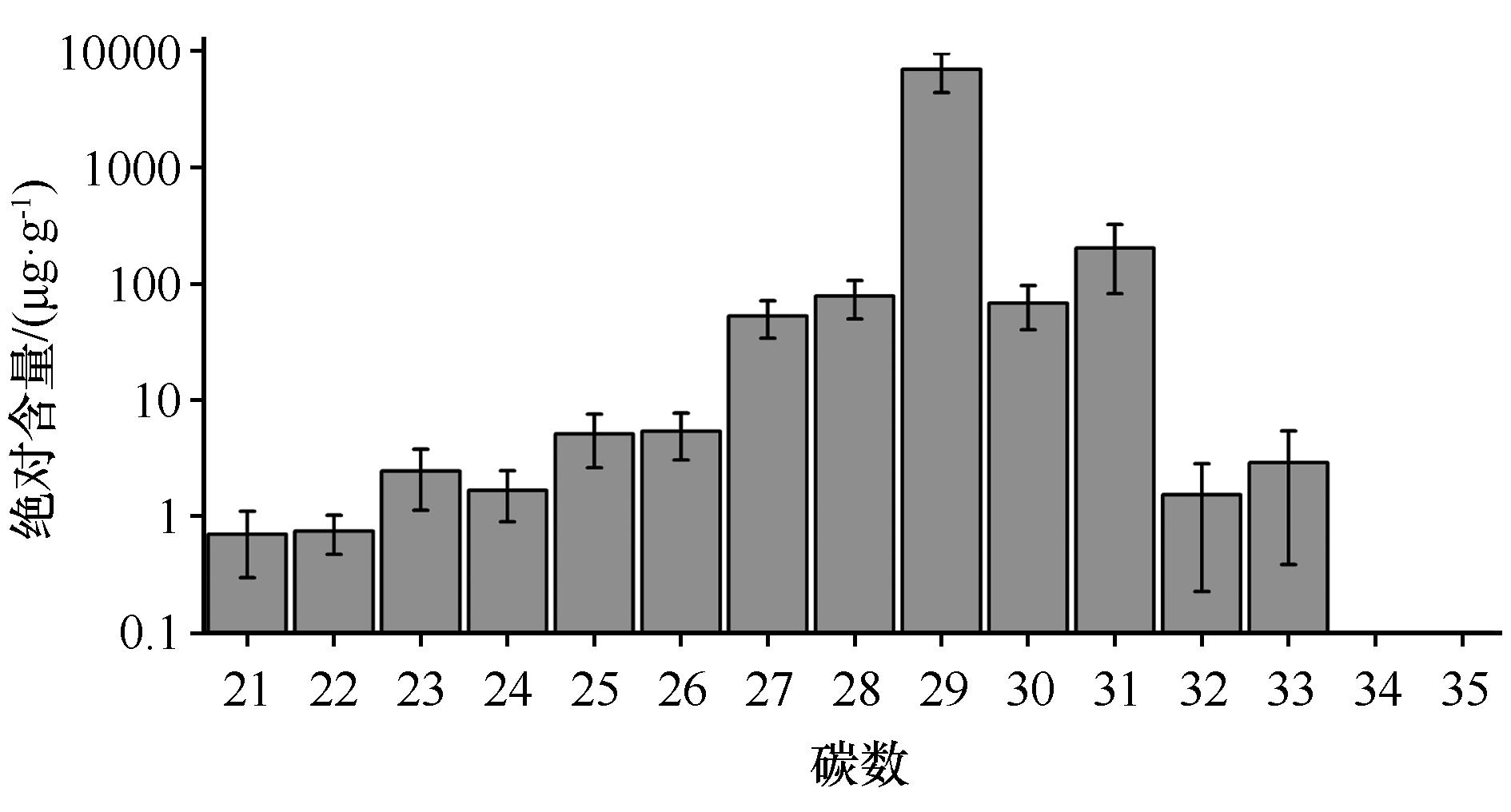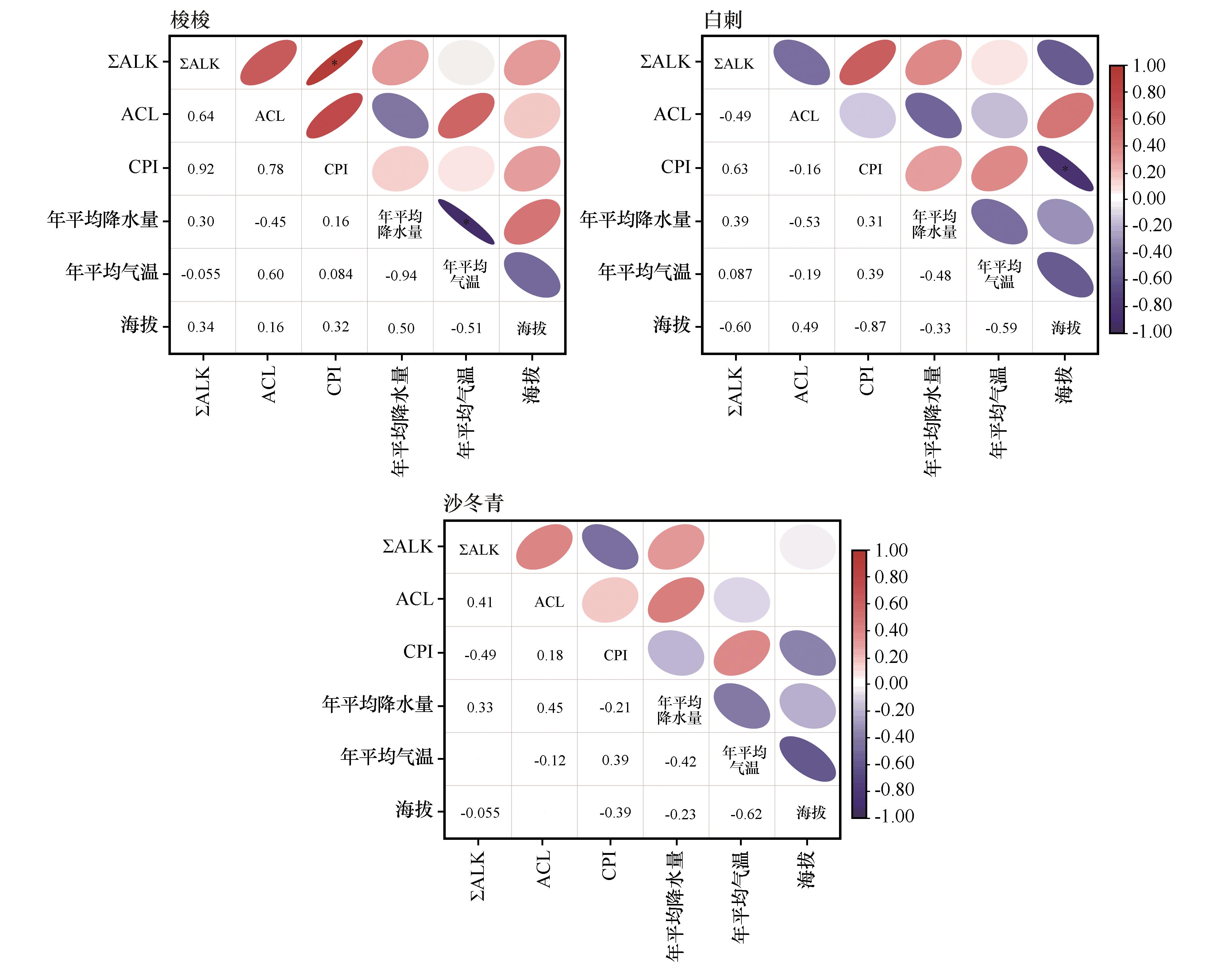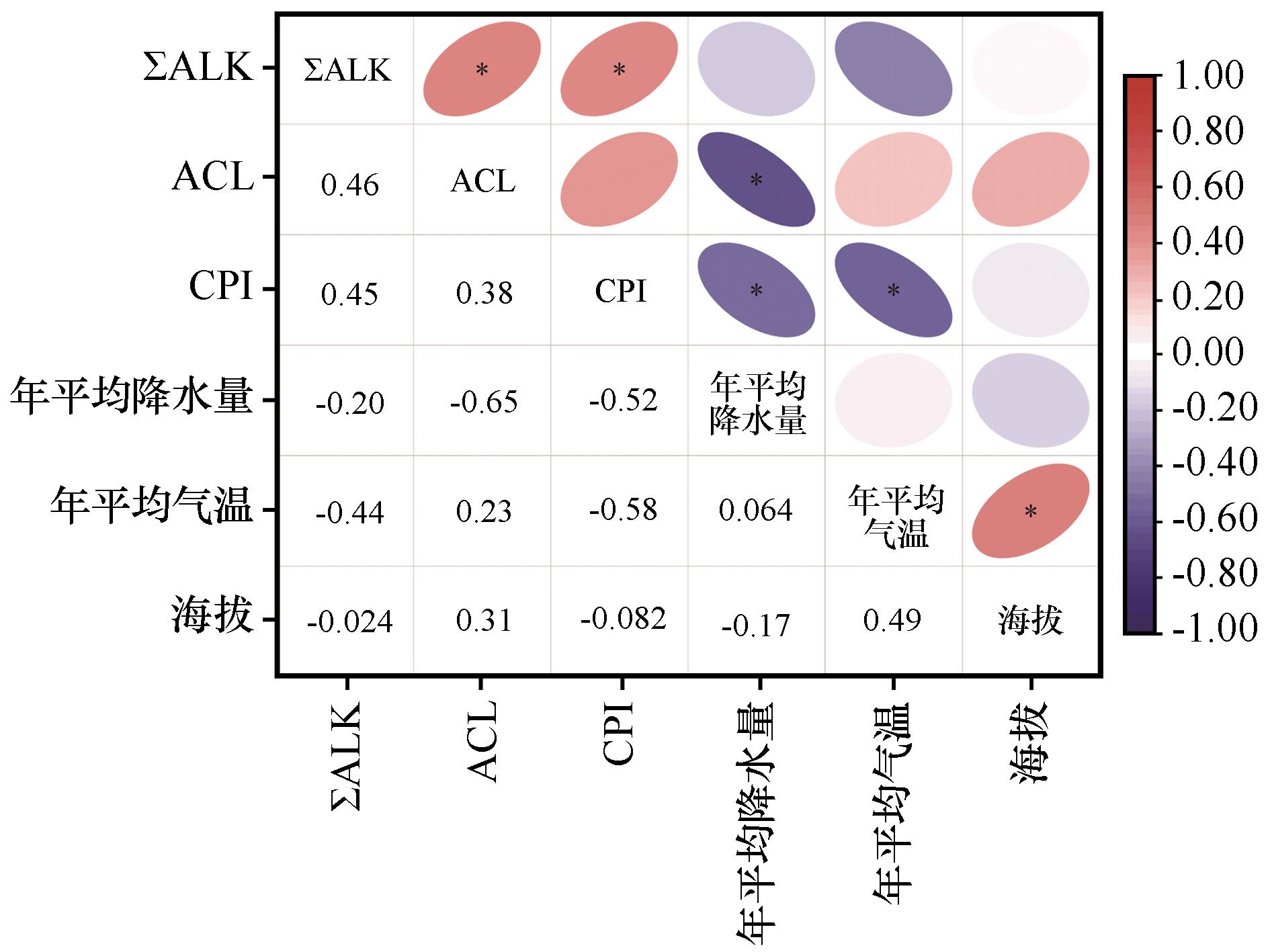中国沙漠 ›› 2025, Vol. 45 ›› Issue (5): 45-54.DOI: 10.7522/j.issn.1000-694X.2025.00006
周尚哲a,b( ), 席磊a,b, 崔梦淳a,b, 崔桂鹏a,b,c, 孔维远a,b,c, 高攀a,b, 卢琦a,b,c(
), 席磊a,b, 崔梦淳a,b, 崔桂鹏a,b,c, 孔维远a,b,c, 高攀a,b, 卢琦a,b,c( )
)
收稿日期:2024-09-25
修回日期:2024-12-24
出版日期:2025-09-20
发布日期:2025-09-27
通讯作者:
卢琦
作者简介:周尚哲(1993—),男,山东东营人,助理研究员,主要研究方向为有机地球化学与古气候演变。E-mail: shangzhe@caf.ac.cn
基金资助:
Shangzhe Zhoua,b( ), Lei Xia,b, Mengchun Cuia,b, Guipeng Cuia,b,c, Weiyuan Konga,b,c, Pan Gaoa,b, Qi Lua,b,c(
), Lei Xia,b, Mengchun Cuia,b, Guipeng Cuia,b,c, Weiyuan Konga,b,c, Pan Gaoa,b, Qi Lua,b,c( )
)
Received:2024-09-25
Revised:2024-12-24
Online:2025-09-20
Published:2025-09-27
Contact:
Qi Lu
摘要:
沉积物中的长链正构烷烃主要来源于高等植物叶蜡,是荒漠区古气候、古环境重建的重要指示物。温度、降水、海拔等环境因子影响了荒漠植物叶蜡正构烷烃的含量和分布特征,但环境因子对荒漠植物叶蜡正构烷烃合成的影响和作用机制尚不清晰。为此,本研究选择对气候环境变化响应高度敏感的乌兰布和沙漠作为研究区,对沙漠北部典型植被的正构烷烃组成、分布以及正构烷烃总量(∑ALK)、平均碳链长度(ACL)和碳优势指数(CPI)指标进行了分析和比较。结果表明:白刺(Nitraria roborowskii)的正构烷烃分布模式以n-C27为主,梭梭(Haloxylon ammodendron)则以n-C27和n-C29为主,而沙冬青(Ammopiptanthus mongolicus)以n-C29为主;梭梭∑ALK和CPI的平均值分别为86 μg·g-1和10.4,白刺为410 μg·g-1和23.3,而沙冬青为7 383 μg·g-1和47.1,3种典型植被的正构烷烃特征差异显著且沙冬青表现尤为特殊。乌兰布和沙漠植被叶蜡正构烷烃∑ALK受降水影响较大,总体上,随降水增加∑ALK表现为增大趋势;另外,随着荒漠植物叶片形态对干旱胁迫的适应性变化,即从卵形到披针形,再到鳞片(退化),其叶蜡正构烷烃特征也出现适应性变异,即ACL和CPI指标表现为逐渐减小的趋势。总体而言,乌兰布和沙漠植被的叶蜡正构烷烃∑ALK、ACL和CPI特征能够有效指示该区干湿变化。
中图分类号:
周尚哲, 席磊, 崔梦淳, 崔桂鹏, 孔维远, 高攀, 卢琦. 乌兰布和沙漠北部典型植被的叶蜡正构烷烃特征及指示[J]. 中国沙漠, 2025, 45(5): 45-54.
Shangzhe Zhou, Lei Xi, Mengchun Cui, Guipeng Cui, Weiyuan Kong, Pan Gao, Qi Lu. Characteristics and implications of leaf wax n-alkanes in typical vegetation of the northern Ulan Buh Desert[J]. Journal of Desert Research, 2025, 45(5): 45-54.
| 采样点 | 经度(E) /(°) | 纬度(N) /(°) | 海拔 /m | 年平均温度/℃ | 年降水量 /mm | 采样点描述 |
|---|---|---|---|---|---|---|
| P1 | 106.95 | 40.23 | 1 048 | 9.3 | 161.6 | 黄河以西流动沙丘,分布植物为白刺、梭梭、沙枣、枸杞、黑沙蒿、柽柳 |
| P2 | 106.91 | 40.20 | 1 058 | 9.2 | 149.9 | 黄河以西流动沙丘,分布植物为白刺、梭梭、榆 |
| P3 | 106.85 | 40.17 | 1 050 | 9.2 | 156.7 | 黄河以西流动沙丘,分布植物为梭梭、北沙柳、细枝岩黄芪、柽柳、沙枣 |
| P4 | 106.82 | 40.15 | 1 050 | 9.4 | 145.5 | 黄河以西流动沙丘,分布植物为白刺、梭梭、柽柳 |
| P5 | 106.87 | 40.27 | 1 048 | 9.3 | 145.8 | 流动沙丘,分布植物为白刺 |
| P6 | 106.70 | 40.44 | 1 037 | 9.3 | 130.7 | 流动沙丘,分布植物为沙冬青 |
| P7 | 106.93 | 40.32 | 1 040 | 9.3 | 153.9 | 磴口县以西流动沙丘,分布植物为沙冬青 |
| P8 | 106.26 | 40.49 | 1 053 | 9.6 | 115.8 | 狼山以南流动沙丘,分布植物为白刺、沙冬青、蒙古扁桃 |
| P9 | 106.05 | 40.39 | 1 154 | 9.2 | 119.2 | 流动沙丘,分布植物为白刺、沙冬青 |
| P10 | 105.98 | 40.17 | 1 047 | 9.8 | 113.3 | 流动沙丘,分布植物为梭梭 |
| P11 | 106.07 | 40.10 | 1 024 | 9.8 | 121.1 | 流动沙丘,分布植物为沙冬青、红砂 |
| P12 | 106.15 | 39.96 | 1 016 | 9.6 | 125.0 | 流动沙丘,分布植物为白刺、梭梭、沙冬青、盐爪爪 |
| P13 | 106.48 | 39.95 | 1 058 | 9.4 | 144.4 | 流动沙丘,分布植物为白刺、沙冬青 |
| P14 | 106.70 | 40.09 | 1 066 | 9.4 | 152.3 | 黄河以西流动沙丘,分布植物为细枝岩黄芪、黑沙蒿 |
表1 采样点信息
Table 1 Sampling site information
| 采样点 | 经度(E) /(°) | 纬度(N) /(°) | 海拔 /m | 年平均温度/℃ | 年降水量 /mm | 采样点描述 |
|---|---|---|---|---|---|---|
| P1 | 106.95 | 40.23 | 1 048 | 9.3 | 161.6 | 黄河以西流动沙丘,分布植物为白刺、梭梭、沙枣、枸杞、黑沙蒿、柽柳 |
| P2 | 106.91 | 40.20 | 1 058 | 9.2 | 149.9 | 黄河以西流动沙丘,分布植物为白刺、梭梭、榆 |
| P3 | 106.85 | 40.17 | 1 050 | 9.2 | 156.7 | 黄河以西流动沙丘,分布植物为梭梭、北沙柳、细枝岩黄芪、柽柳、沙枣 |
| P4 | 106.82 | 40.15 | 1 050 | 9.4 | 145.5 | 黄河以西流动沙丘,分布植物为白刺、梭梭、柽柳 |
| P5 | 106.87 | 40.27 | 1 048 | 9.3 | 145.8 | 流动沙丘,分布植物为白刺 |
| P6 | 106.70 | 40.44 | 1 037 | 9.3 | 130.7 | 流动沙丘,分布植物为沙冬青 |
| P7 | 106.93 | 40.32 | 1 040 | 9.3 | 153.9 | 磴口县以西流动沙丘,分布植物为沙冬青 |
| P8 | 106.26 | 40.49 | 1 053 | 9.6 | 115.8 | 狼山以南流动沙丘,分布植物为白刺、沙冬青、蒙古扁桃 |
| P9 | 106.05 | 40.39 | 1 154 | 9.2 | 119.2 | 流动沙丘,分布植物为白刺、沙冬青 |
| P10 | 105.98 | 40.17 | 1 047 | 9.8 | 113.3 | 流动沙丘,分布植物为梭梭 |
| P11 | 106.07 | 40.10 | 1 024 | 9.8 | 121.1 | 流动沙丘,分布植物为沙冬青、红砂 |
| P12 | 106.15 | 39.96 | 1 016 | 9.6 | 125.0 | 流动沙丘,分布植物为白刺、梭梭、沙冬青、盐爪爪 |
| P13 | 106.48 | 39.95 | 1 058 | 9.4 | 144.4 | 流动沙丘,分布植物为白刺、沙冬青 |
| P14 | 106.70 | 40.09 | 1 066 | 9.4 | 152.3 | 黄河以西流动沙丘,分布植物为细枝岩黄芪、黑沙蒿 |
| 植物种拉丁名 | 种名 | 属 | 科 | 生活型 | 叶形 |
|---|---|---|---|---|---|
| Haloxylon ammodendron | 梭梭 | 梭梭属 | 藜科 | 小乔木 | 鳞片状宽三角形,同化枝 |
| Nitraria roborowskii | 白刺 | 白刺属 | 白刺科 | 灌木 | 宽倒披针形 |
| Ammopiptanthus mongolicus | 沙冬青 | 沙冬青属 | 豆科 | 常绿灌木 | 菱状椭圆形、阔披针形 |
表2 典型植物叶片样品信息
Table 2 Typical plant leaf sample information
| 植物种拉丁名 | 种名 | 属 | 科 | 生活型 | 叶形 |
|---|---|---|---|---|---|
| Haloxylon ammodendron | 梭梭 | 梭梭属 | 藜科 | 小乔木 | 鳞片状宽三角形,同化枝 |
| Nitraria roborowskii | 白刺 | 白刺属 | 白刺科 | 灌木 | 宽倒披针形 |
| Ammopiptanthus mongolicus | 沙冬青 | 沙冬青属 | 豆科 | 常绿灌木 | 菱状椭圆形、阔披针形 |

图3 乌兰布和沙漠的沙冬青叶蜡正构烷烃绝对含量的分布模式注:纵坐标轴为对数坐标轴
Fig.3 Distribution pattern of the absolute abundance of n-alkanes in the leaf wax of Ammopiptanthus mongolicus in the Ulan Buh Desert

图4 乌兰布和沙漠典型植被的叶蜡正构烷烃指标与环境因子相关系数指示图注:∑ALK表示正构烷烃总量,ACL表示平均碳链长度,CPI表示碳优势指数。椭圆颜色和颜色深浅表示指标之间的相关性,红色为正相关,蓝色为负相关。*表示P≤0.05。下同
Fig.4 Correlation coefficient diagram between leaf wax n-alkane proxies and environmental factors of typical vegetation in the Ulan Buh Desert

图5 乌兰布和与古尔班通古特沙漠梭梭的叶蜡正构烷烃指标与环境因子相关系数指示图
Fig.5 Correlation coefficient diagram between leaf wax n-alkane proxies and environmental factors of Haloxylon ammodendron in the Ulan Buh and Gurbantunggut Desert
| 植物种 | CMAX | ∑ALK21-35/(μg·g-1) | ACL21-35 | CPI21-35 |
|---|---|---|---|---|
| 梭梭 | 27, 29 | 86±32 (51~131) | 27.5±0.4 (27.3~28.2) | 10.4±1.6 (8.3~12.3) |
| 白刺 | 27 | 410±168 (201~653) | 27.9±0.3 (27.3~28.2) | 23.2±8.2 (6.5~33.7) |
| 沙冬青 | 29 | 7 383±2 742 (2 452~10 111) | 29.0±0.0 (29.0~29.1) | 47.1±3.2 (44.1~53.4) |
表3 典型植被的叶蜡正构烷烃指标
Table 3 Leaf wax n-alkane proxies in typical vegetation
| 植物种 | CMAX | ∑ALK21-35/(μg·g-1) | ACL21-35 | CPI21-35 |
|---|---|---|---|---|
| 梭梭 | 27, 29 | 86±32 (51~131) | 27.5±0.4 (27.3~28.2) | 10.4±1.6 (8.3~12.3) |
| 白刺 | 27 | 410±168 (201~653) | 27.9±0.3 (27.3~28.2) | 23.2±8.2 (6.5~33.7) |
| 沙冬青 | 29 | 7 383±2 742 (2 452~10 111) | 29.0±0.0 (29.0~29.1) | 47.1±3.2 (44.1~53.4) |

图6 干旱胁迫下乌兰布和沙漠典型植被的叶形和叶蜡正构烷烃特征适应性变化注:不同字母表示植物间差异性显著
Fig.6 Adaptive changes in leaf morphology and leaf wax n-alkane characteristics of typical vegetation in the Ulan Buh Desert under drought stress

图7 干旱胁迫下乌兰布和沙漠植被的叶形和叶蜡正构烷烃特征适应性变化注:不同字母表示植物间差异性显著
Fig.7 Adaptive changes in leaf morphology and leaf wax n-alkane characteristics of vegetation in the Ulan Buh Desert under drought stress
| [1] | 王涛.我国沙漠化研究的若干问题:2.沙漠化的研究内容[J].中国沙漠,2003,23(5):1-6. |
| [2] | 鹿化煜,周亚利, Mason J,等.中国北方晚第四纪气候变化的沙漠与黄土记录:以光释光年代为基础的直接对比[J].第四纪研究,2006,26(6):888-894. |
| [3] | 鹿化煜,李郎平,弋双文,等.中国北方沙漠-黄土体系的沉积和侵蚀过程与未来趋向探析[J].地学前缘,2010,17(5):336-344. |
| [4] | 侯仁之,俞伟超.乌兰布和沙漠的考古发现和地理环境的变迁[J].考古,1973,2:92-107. |
| [5] | 贾铁飞,银山,何雨,等.乌兰布和沙漠东海子湖全新世湖相沉积结构分析及其环境意义[J].中国沙漠,2003,23(2):165-170. |
| [6] | 贾铁飞,银山.乌兰布和沙漠北部全新世地貌演化[J].地理科学,2004,24(2):217-221. |
| [7] | 春喜,陈发虎,范育新,等.乌兰布和沙漠的形成与环境变化[J].中国沙漠,2007,27(6):927-931. |
| [8] | 陈发虎,范育新,春喜,等.晚第四纪“吉兰泰–河套”古大湖的初步研究[J].科学通报,2008,53(10):1207-1219. |
| [9] | 范育新,陈发虎,范天来,等.乌兰布和沙漠景观形成的沉积学和光释光年代学证据[J].中国科学:地球科学,2010,40(7):903-910. |
| [10] | 赵杰,李德文,孙昌斌,等.末次冰期以来乌兰布和沙漠北缘的环境变迁[J].第四纪研究,2017,37(2):380-392. |
| [11] | 杨小平,梁鹏,方伊曼,等.中国沙漠与环境演变[M].北京:科学出版社,2024:1-349. |
| [12] | Chun X, Chen F, Fan Y,et al.Formation of Ulan Buh Desert and its environmental changes during the Holocene[J].Frontiers of Earth Science in China,2008,2(3):327-332. |
| [13] | Zhao H, Li G, Sheng Y,et al.Early-middle Holocene lake-desert evolution in northern Ulan Buh Desert, China[J]. Palaeogeography Palaeoclimatology Palaeoecology,2012,331/332:31-38. |
| [14] | 陈雪梅,李国强,黄小忠,等.乌兰布和沙漠钻孔WL10ZK-1孢粉记录的末次冰期以来的植被变化[J].海洋地质与第四纪地质,2013,33(4):169-174. |
| [15] | Chen F, Li G, Zhao H,et al.Landscape evolution of the Ulan Buh Desert in northern China during the late Quaternary[J].Quaternary Research,2014,81(3):476-487. |
| [16] | Zhang W, Lu H, Li C,et al.Pollen preservation and its potential influence on paleoenvironmental reconstruction in Chinese loess deposits[J].Review of Palaeobotany and Palynology,2017,240:1-10. |
| [17] | 高有红,李卓仑,韩朗,等.阿拉善沙漠植物钙质根管:形态特征、分类及其环境指示意义[J].沉积学报,2017,35(1):75-84. |
| [18] | Ning K, Wang N, Lv X,et al.A grain size and n-alkanes record of Holocene environmental evolution from a groundwater recharge lake in Badain Jaran Desert,Northwestern China[J]. The Holocene,2019,29(6):1045-1058. |
| [19] | Xie M, Sun Q, Dong H,et al. n-Alkanes and compound carbon isotope records from Lake Yiheshariwusu in the Hulun Buir sandy land, northeastern China[J].The Holocene,2020,30(10):1451-1461. |
| [20] | Eglinton G, Hamilton R.Leaf epicuticular waxes[J].Science,1967,156(3780):1322-1335. |
| [21] | Feakins S, Eglinton T, deMenocal P.A comparison of biomarker records of northeast African vegetation from lacustrine and marine sediments (ca. 3.40 Ma)[J].Organic Geochemistry,2007,38(10):1607-1624. |
| [22] | Garcin Y, Schefuß E, Schwab V,et al.Reconstructing C3 and C4 vegetation cover using n-alkane carbon isotope ratios in recent lake sediments from Cameroon,Western Central Africa[J].Geochimica et Cosmochimica Acta,2014,142(1):482-500. |
| [23] | Diefendorf A, Freimuth E.Extracting the most from terrestrial plant-derived n-alkyl lipids and their carbon isotopes from the sedimentary record: a review[J].Organic Geochemistry,2017,103:1-21. |
| [24] | Zhang D, Beverly E, Levin N,et al.Carbon isotopic composition of plant waxes,bulk organics and carbonates from soils of the Serengeti grasslands[J].Geochimica et Cosmochimica Acta,2021,311:316-331. |
| [25] | Dodd R, Poveda M.Environmental gradients and population divergence contribute to variation in cuticular wax composition in Juniperus communis [J].Biochemical Systematics and Ecology,2003,31(11):1257-1270. |
| [26] | Sachse D, Radke J, Gleixner G. δD values of individual n-alkanes from terrestrial plants along a climatic gradient-Implications for the sedimentary biomarker record[J].Organic Geochemistry,2006,37(4):469-483. |
| [27] | Hoffmann B, Kahmen A, Cernusak L,et al.Abundance and distribution of leaf wax n-alkanes in leaves of Acacia and Eucalyptus trees along a strong humidity gradient in northern Australia[J].Organic Geochemistry,2013,62(1):62-67. |
| [28] | Bush R, McInerney F.Influence of temperature and C4 abundance on n-alkane chain length distributions across the Central USA[J].Organic Geochemistry,2015,79:65-73. |
| [29] | Feakins S, Peters T, Wu M,et al.Production of leaf wax n-alkanes across a tropical forest elevation transect[J].Organic Geochemistry,2016,100:89-100. |
| [30] | Shi M, Han J, Wang G,et al.A long-term investigation of the variation in leaf wax n-alkanes responding to climate on Dongling Mountain,North China[J].Quaternary International,2021,592:67-79. |
| [31] | Han Y, Wang G, Sun Q,et al.Variability of leaf wax n-alkanes across gradients of environment and plant functional type in China[J].Global and Planetary Change,2024,237:104441. |
| [32] | Bray E, Evans E.Distribution of n-paraffins as a clue to recognition of source beds[J].Geochimica Et Cosmochimica Acta,1961,22(1):2-15. |
| [33] | Cranwell P.Chain-length distribution of n-alkanes from lake sediments in relation to post-glacial environmental change[J].Freshwater Biology,1973,3(3):259-265. |
| [34] | Jeng W.Higher plant n-alkane average chain length as an indicator of petrogenic hydrocarbon contamination in marine sediments[J].Marine Chemistry,2006,102(3/4):242-251. |
| [35] | Vogts A, Moossen H, Rommerskirchen F,et al.Distribution patterns and stable carbon isotopic composition of alkanes and alkan-1-ols from plant waxes of African rain forest and savanna C3 species[J].Organic Geochemistry,2009,40(10):1037-1054. |
| [36] | Tipple B, Pagani M.Environmental control on eastern broadleaf forest species' leaf wax distributions and D/H ratios[J].Geochimica et Cosmochimica Acta,2013,111:64-77. |
| [37] | Wang J, Axia E, Xu Y,et al.Temperature effect on abundance and distribution of leaf wax n-alkanes across a temperature gradient along the 400 mm isohyet in China[J].Organic Geochemistry,2018,120:31-41. |
| [38] | Liu J.Seasonality of the altitude effect on leaf wax n-alkane distributions,hydrogen and carbon isotopes along an arid transect in the Qinling Mountains[J].Science of the Total Environment,2021,778:146272. |
| [39] | Liu X, Feakins S, Dong X,et al.Experimental study of leaf wax n-alkane response in winter wheat cultivars to drought conditions[J].Organic Geochemistry,2017,113:210-223. |
| [40] | Huang X, Zhao B, Wang K,et al.Seasonal variations of leaf wax n-alkane molecular composition and delta D values in two subtropical deciduous tree species: results from a three-year monitoring program in Central China[J].Organic Geochemistry,2018,118:15-26. |
| [41] | Jiang H, Feakins S, Sun H,et al.Dynamic changes in leaf wax n-alkanes and δ 13C during leaf development in winter wheat under varied irrigation experiments[J].Organic Geochemistry,2020,146:104054. |
| [42] | Baker E.The influence of environment on leaf wax development in Brassica oleracea var.gemmifera [J].New Phytologist,1974,73(5):955-966. |
| [43] | Shepherd T, Robertson G, Griffiths D,et al.Effects of environment on the composition of epicuticular wax esters from kale and swede[J].Phytochemistry,1997,46(1):83-96. |
| [44] | Kim K, Park S, Jenks M.Changes in leaf cuticular waxes of sesame (Sesamum indicum L.) plants exposed to water deficit[J].Journal of Plant Physiology,2007,164(9):1134-1143. |
| [45] | 乌拉.乌兰布和沙漠植被及其保护[J].陕西林业科技,2007,4:133-137. |
| [46] | Rieley G, Collier R, Jones D,et al.The biogeochemistry of Ellesmere Lake,U.K.-I: source correlation of leaf wax inputs to the sedimentary record[J].Organic Geochemistry,1991,17(6):901-912. |
| [47] | Rommerskirchen F, Plader A, Eglinton G,et al.Chemotaxonomic significance of distribution and stable carbon isotopic composition of long-chain alkanes and alkan-1-ols in C4 grass waxes[J].Organic Geochemistry,2006,37(10):1303-1332. |
| [48] | 崔景伟,黄俊华,谢树成.湖北清江现代植物叶片正构烷烃和烯烃的季节性变化[J].科学通报,2008,53(11):1318-1323. |
| [49] | Zech M, Buggle B, Leiber K,et al.Reconstructing Quaternary vegetation history in the Carpathian Basin,SE Europe,using n-alkane biomarkers as molecular fossils: problems and possible solutions,potential and limitations[J].Eiszeitalter and Gegenwart-Quaternary Science Journal,2009,58(2):148-155. |
| [50] | 钟艳霞,薛骞,陈发虎.黄土高原西部地区现代植被及其表土正构烷烃分布模式研究[J].第四纪研究,2009,29(4):767-773. |
| [51] | 饶志国,吴翼,朱照宇,等.长链正构烷烃主峰碳数作为判别草本和木本植物指标的讨论:来自表土和现代植物的证据[J].科学通报,2011,56(10):774-780. |
| [52] | Ceccopieri M, Scofield A, Almeida L,et al.Carbon isotopic composition of leaf wax n-alkanes in mangrove plants along a latitudinal gradient in Brazil[J].Organic Geochemistry,2021,161:104299. |
| [53] | 石敏锐,韩家懋,周力平,等.植物亲缘关系影响植物叶蜡正构烷烃的含量和分布特征[J].第四纪研究,2021,41(4):986-999. |
| [54] | Yan Y, Zhao B, Xie L,et al.Trend reversal of soil n-alkane Carbon Preference Index (CPI) along the precipitation gradient and its paleoclimatic implication[J].Chemical Geology,2021,581:120402. |
| [55] | 吴征镒.中国植被[M].北京:科学出版社,1978:1-1364. |
| [56] | 侯学煜.中国自然地理:植物地理(下册)[M].北京:科学出版社,1988:1-279. |
| [57] | 刘亚楠,陈晓娜,郭跃,等.沙旱生灌木对干旱胁迫的响应研究进展[J].世界林业研究,2023,36(5):21-26. |
| [58] | 段娜,王佳,刘芳,等.植物抗旱性研究进展[J].分子植物育种,2018,16(15):5093-5099. |
| [59] | 张耀甲.甘肃民勤地区主要沙区植物的生态生理特性[J].生态学杂志,1984,1:1-4. |
| [60] | 张露荷,赵通,黄华梨,等.“赞皇大枣”和“冬枣”对干旱胁迫的生理响应[J].干旱地区农业研究,2023,41(3):104-113. |
| [1] | 丁甲, 唐逸云, 李蕾, 杨宏玉, 张泽琦, 王君, 余舒畅, 冯金朝, 石莎, 杨昊天. 土壤水分与氮含量对宁夏荒漠草原甘肃蒿( Artemisia gansuensis )、胡枝子( Lespedeza bicolor )、针茅( Stipa capillata )生理的影响[J]. 中国沙漠, 2025, 45(3): 271-282. |
| [2] | 杨岩岩, 刘连友, 吴波, 庞营军. 沙丘埋压对典型荒漠植物枝条枯落物分解的影响[J]. 中国沙漠, 2025, 45(3): 313-325. |
| [3] | 张红霞, 贾荣亮, 赵鹏善, 赵昕, 崔晓云. 荒漠植物逆境生理生态学研究进展[J]. 中国沙漠, 2025, 45(3): 72-79. |
| [4] | 曹昱轩, 李锦荣, 杨旭, 娜玛罕, 武恒博, 屈鹏程. 乌兰布和沙漠植被因子对风沙活动特征的影响[J]. 中国沙漠, 2025, 45(2): 37-46. |
| [5] | 李锦荣, 韩兆恩, 崔崴, 金筱霖, 豆春花. 沙丘冻结表面风沙传输特征的风洞模拟研究[J]. 中国沙漠, 2025, 45(1): 229-241. |
| [6] | 雍天, 张金霞, 陈丽娟, 席海洋, 张斌武, 甘开元. 乌兰布和沙漠沿黄河段土壤水盐空间分异特征及其成因[J]. 中国沙漠, 2024, 44(3): 247-258. |
| [7] | 乌友罕, 殷婕, 武子丰, 哈斯额尔敦. 巴丹吉林-乌兰布和沙漠输沙带新月形沙丘动态[J]. 中国沙漠, 2024, 44(2): 78-89. |
| [8] | 满多清, 唐进年, 杨雪梅, 李得禄, 郭树江, 陈芳, 丁峰. 1960—2021年民勤沙区10种典型荒漠植物种群变化特征[J]. 中国沙漠, 2023, 43(6): 20-28. |
| [9] | 李永山, 贾晓鹏, 王海兵, 王建, 马启民. 1966—2019年黄河乌兰布和沙漠宽谷段河道深泓横向摆动特征[J]. 中国沙漠, 2023, 43(5): 59-65. |
| [10] | 甘开元, 张金霞, 陈丽娟, 席海洋, 张斌武, 雍天, 卫雨西. 乌兰布和沙漠沿黄河段植物群落特征及空间分异[J]. 中国沙漠, 2023, 43(4): 180-190. |
| [11] | 李映坤, 李锦荣, 董雷, 罗祥英, 韩兆恩, 王茹. 乌兰布和沙漠周边典型植物群落防风阻沙效果[J]. 中国沙漠, 2022, 42(6): 65-73. |
| [12] | 李星, 马媛, 李星, 高君亮, 辛智鸣, 卢琦. 乌兰布和沙漠植物群落相异性及其影响因素[J]. 中国沙漠, 2022, 42(5): 187-194. |
| [13] | 刘雅莉, 白建华, 熊伟, 韩雨晴, 廉泓林, 郭浩, 辛智鸣, 刘湘杰, 刘怀远. 乌兰布和沙漠梭梭( Haloxylon ammodendron )夜间液流特征及其环境驱动机制[J]. 中国沙漠, 2022, 42(5): 195-203. |
| [14] | 赵春彦, 秦洁, 贺晓慧, 周冬蒙. 轻度沙埋对典型荒漠植物的影响[J]. 中国沙漠, 2022, 42(5): 63-72. |
| [15] | 杨迎, 吕萍, 马芳, 梁准, 许明静. 乌兰布和沙漠西南部风况对穹状沙丘形成的影响[J]. 中国沙漠, 2021, 41(2): 19-26. |
| 阅读次数 | ||||||
|
全文 |
|
|||||
|
摘要 |
|
|||||
©2018中国沙漠 编辑部
地址: 兰州市天水中路8号 (730000)
电话:0931-8267545
Email:caiedit@lzb.ac.cn;desert@lzb.ac.cn
